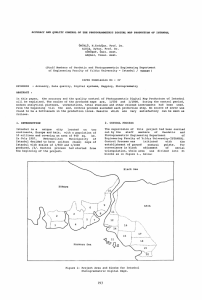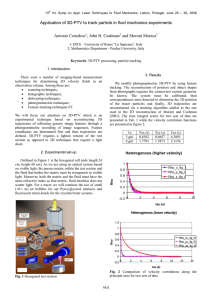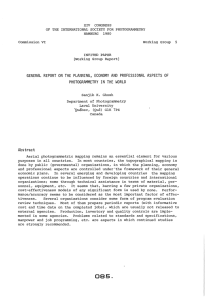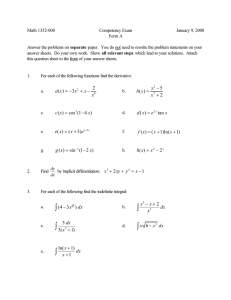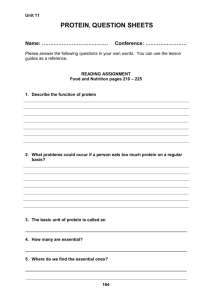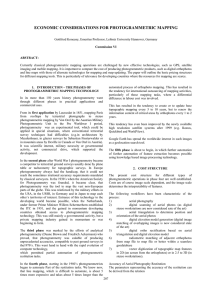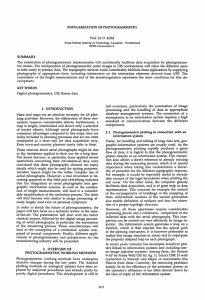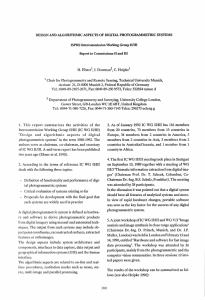14TH CONGRESS OF THE INTERNATIONAL ... HAMBURG 1980 PRESENTED PAPER COMMISSION No. VI
advertisement
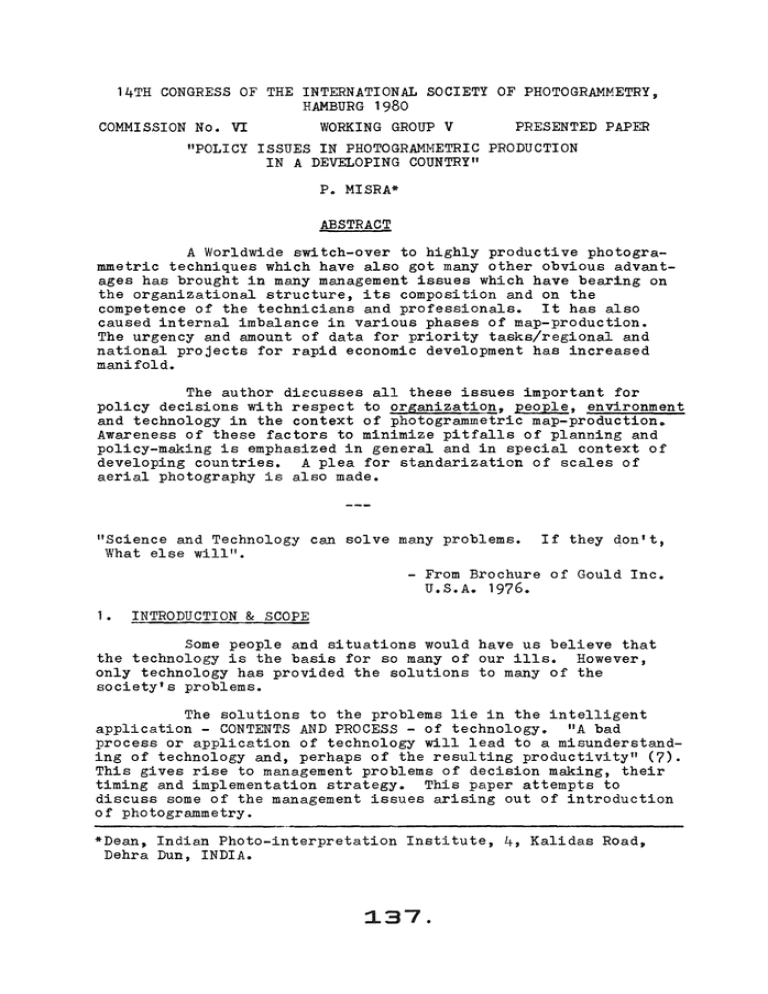
14TH CONGRESS OF THE INTERNATIONAL SOCIETY OF PHOTOGRAMMETRY, HAMBURG 1980 PRESENTED PAPER COMMISSION No. VI WORKING GROUP V "POLICY ISSUES IN PHOTOGRAMNETRIC PRODUCTION IN A DEVELOPING COUNTRY" P. MISRA* ABSTRACT A Worldwide switch-over to highly productive photogrammetric techniques which have also got many other obvious advantages has brought in many management issues which have bearing on the organizational structure, its composition and on the competence of the technicians and professionals. It has also caused internal imbalance in various phases of map-production. The urgency and amount of data for priority tasks/regional and national projects for rapid economic development has increased manifold. The author discusses all these issues important for policy decisions with respect to organization, people, environment and technology in the context of photogrammetric map-production. Awareness of these factors to minimize pitfalls of planning and policy-making is emphasized in general and in special context of developing countries. A plea for standarization of scales of aerial photography is also made. "Science and Technology can solve many problems. If they don't, What else will". - From Brochure of Gould Inc. u.s.A. 1976. 1. INTRODUCTION & SCOPE Some people and situations would have us believe that the technology is the basis for so many of our ills. However, only technology has provided the solutions to many of the society's problems. The solutions to the problems lie in the intelligent application - CONTENTS AND PROCESS - of technology. "A bad process or application of technology will lead to a misunderstanding of technology and, perhaps of the resulting productivityn (7). This gives rise to management problems of decision making, their timing and implementation strategy. This paper attempts to discuss some of the management issues arising out of introduction of photogrammetry. *Dean, Indian Photo-interpretation Institute, 4, Kalidas Road, Dehra Dun, INDIA. :1.37. 2. INTERRELATIONSHIP BETWEEN PARTS :F'ig. 1 Parts of Organizational Entity. The figure 1, based on Leavitt (2) is self explanatory of the parts of an organizational entity. All the parts interact with one another. In this paper we are concerned with the interaction between 'Technology' and 'Structure', and 'Technology' and 'Environment'. The discussion on Technology and People, although very important will need more paper space and is, therefore, left out. Before understanding this interaction, let us consider the appropriateness of technology or technological objectives. 3. ESTABLISHING OF APPROPRIATE rECIDiOLOGY A major attribute of the production of maps by employing photogrammetric techniques is the saving of the cost and time. However, any technique or system can be termed better only if it can stand the scientific tests for its so called 'betterness'. In a survey/map production environment this 1 betterness' can be seen in a rather simple manner. 4. 11 BETTERNESS 11 OF TECHNIQUE In map production process as in many other cases, there is multi-objectivity. This means that we, as producers of maps, wish to achieve several objectives, namely (Q)uality increase in (Q)uantity increase in reduction of (C) ost Besides these, there could be many other sought after attributes :1.38. like versatility, reliability and socio-economic objectives. We say that a particular ~ technique is 'better' than the old one only if we can measure the effectiveness (through Q,Q,C analysis) of the new one and prove that the new technique is better. 5. MAPPING OBJECTIVES IN A DEVELOPING COUNTRY IS GENERALLY "TIME" IN PREFERENCE TO "COST". In a developing economy, it will be worthwhile to note that 'Time-effectiveness' of technique plays a major role in its acceptance. The map users are rather indifferent to a marginal (in some cases substantial) cost increase if the maps could be delivered to them earlier. The pressure of the development is such that the maps are required almost 'immediately'. A major problem in a developing country is then "how to reduce the time cycle of production of maps". 6. A CRITICAL LOOK AT THE TIME CYCLE OF PRODUCING A MAP IN INDIA (Concept of Stored-controlled-photogrammetric Models). s:: 0 tr.l 8 ro (J) (I) (J) H '0 r:r: ~ Field Controli---,...,Adjustment ...... t---~ Aerial Triangulation (I) ·r-1 ~ ' s::0 ~·-------------------~~ tf} Plotting !-- ro ~ 0 OJ (J) (_) '0 rz-1 .-I (J) OJ -r-1 Iii Verification Checking ,_..-------------!Contouring Compilation Fig. 2 Present Working System by Field Seasons. Referring to figure 2, we see that the first field season (October-April) and the following recess (office work from May to September) are spent in field control work. adjustment and aerial triangulation. Thus conventional method will generally take a minimum of two field seasons to finish the job. It is, however, possible to delink the operations of the 'first field :139. season' from the operations in the recess. In order to do this, the models from existing photography in selected areas should be field controlled and subsequently photo-triangulated. The controlled-photogrammetric models shou~d be stored for any subsequent use. The areas for this type of work should be those which are development-prone and can be easily decided by the planners. If any demand of surveys is projected suddenly we can straightway use the existing controlled-models for planimetry. The contouring can be done either by ground surveys (suits developing countries where labour is comparatively inexpensive) or through low flown photography which can be ordered as soon as the project details are finalized. As a corollary of the above, standardization of the photographic scales is strongly recommended. 7. STANDARDIZATION OF AERIAL PHOTOGRAPHIC SCALES The aerial photography scales should be standardized to derive more benefits in map production e.g. saving of flying effort, time, and generating understanding with the users. The suggested scales are given below (6). Standard scales of aerial photography and their propo~ed use: Scale of aerial photography a) 1:50,000 :(All India coverage) Used for revision of 1:250,000 surveys Used for quick planimetry upto 1:15000 scale. Planimetry can be in the form of photo-image or plotted section. For contouring upto 10 metres contour interval. b) 1:20,000 (Covering development-prone areas say 75%-80% of 1:50,000 coverage) :- Used for mapping of 1:25,000 scale. Used for quick planimetry upto 1:5,000 scale (line or photo-image). Used for interpretation job. Used for cadastral surveys on 1:5,000 scale and town surveys. c) 1: 10 ,ooo :- Used for densification of ground control by photogrammetric means (1) Used for very large scale tasks e.g. Water Nanagement for River Command Area tasks. Used for very close contour intervals. OR 1:6,000 (Specific areas only) The contour intervals of engineering surveys are generally very close. For example, Canal area surveys are having 1 metre where as Command Area Surveys have 25 ems. as contour interval. Two clear alternatives are available, namely, contour- :1.40. ing by photogrammetric means and contouring by ground methods. Photogrammetric method would entail aerial photography on large scale resulting in innumerable models and subsequent heavy work. Comparatively, ground surveys entail a lot of expenditure but in socio-economic environment of providing jobs to weaker sections of society, it is, perhaps, justified in developing countries. However, each survey project, as mentioned earlier, has to be designed separately and cost effectiveness and/or time-effectiveness has to be seen by the designer. Some of these are shown graphically in Fig. 3. p~~~~;!ap~ ~-P-h_o:t_o--g~r~~am~m~e-tr+i~c~w_o~r_k4-~~r-F~l-·e+l-d+-W+o_r~k-r-r-C+ar~_,tography drop line method low-flown model 4 ~ contoured sheet'-........ I ....___----' I -......... ""--. High- flown ,. ., model/ stereo instr. / / I ......... verification cartography field contour \ \ \ \ \ \ "' \ \ \ \ spot heights -----A - - - - - - - - --} B -------c Fig. 3 8. I I I I I I I I I D Flow chart showing alternate courses. ORGANIZATION AND STRUCTURE The structure is not merely the hierarchy but the system of communication, system of authority or other roles and system of work flow (2). For this paper, however, we are considering only the hierarchy and manpower distribution within a Directorate. Although, this approach is not complete, nevertheless it allows our attention to focus on the relationship we are concerned with, namely 1 Technology 1 an.d 1 Structure' • Structure of a representative Directorate of Survey of India (3) Let us condier the hierarchy of a traditional Directorate, without any photogrammetry party. The structure of the directorate is shown in figure 4. Director Dy. Director Dy. Director F.P.1 F.P.2 = Fi~ld F.P. F.P.4 F.P.3 Par~ 5 Supervisors 24 Technical Hands Fig. 4 Note:- Drawing Office prawing Office 8-10 Supervisors 80 Technical Hands F.P.5 Structure of a Directorate vdth no Photogrammetry Party. A party is organized on the basis of a self-sufficient Project Office. It has the necessary resources to undertake a conventional survey task. Director Dy.Director Dy.Director F.P.1 F.P.2 F.P.3 Fig. 5 9. F.P.4 F.P.5 Drawing Office Photogrammetric Party (2 to 3 Control Instruments 5 to 7 Plotting Instruments) Structure of a Directorate with one Photogrammetry Party. BALANCE BETWEEN PRODUCTIYITY OF VARIOUS PHASES OF SURVEYING AND MAPPING ~4) A. Traditional Structure On an average, the following is obtainable from a Field Party: Field output (in terms of 1:50,000 sheets) Per Party (Surveying by ground methods only). Field work is resorted to for about 6 months in winter season 8 sheets.* * (will vary according to the terrain). Drawing output (in terms of 1:50,000 sheets) Per Party during summer months when there is no field work 8 sheets* Therefore, there is No backlog of fairdrawing work in the next field season. The Directorate also is generally balanced so long as the output of 8 sheets Per Party (or equivalent) is maintained. B. Structure with Photogrammetric Support Since there is a photogrammetric complement, the field work is mainly to support: a) Stereo-triangulation b) Verification of Photogrammetrically plotted sections. The control-complement of the Field Parties is employed to carry out pre-specified photo-oriented control work. This may generally be for a big 'block' or for controlling individual models. Thus, control-output of a Field Party is not consumed by itself. Instead, it becomes the INPUT to the photogrammetric process. The output of the Photogrammetric Unit comes out in the form of plotted sections. These plotted sections, after transforming them into field-worthy materials are then ready to be given to a Field Party. Thus, they form an input and workload for the 24 field hands of a Field Party. The difference as compared to traditional ground method is obviously in the increased productivity of the photogrammetric process. An oversimplified statement can be made that the increase in productivity due to the photogrammetry is 2 to 3 times. How does this all affect the balance? The answer is obvious. The internal balance of the field party is disturbed. Consider an example: Field Party does control for 16 1:50,000 sheets for Photo Party Photo Party sends plotted Sections for 16, 1:50,000 sheets to Field Party First Field Season, Year Second Field Season, Year 2 Verified Sections ready for fair drawing in Field Party Field Party during recess can fair draw Backlog - of field verified plotted sections to be transferred to Drawing Office. Recess - Y~ar 2 16 sheets. - 8 sheets 8 sheets * (will vary according to the terrain). Backlog from re!nalnlng field parties 4x8 (assuming that there are 5 Field Parties) Total backlog per year of 1:50,000 sheets - 32 sheets =~~=~g~~~~ It is evident from above that whereas the productivity of the Directorate in so far as 1:50,000 sheets is concerned is increased two times, the balance between various phases of work, namely, field and cartography even if the whole Directorate is taken into account, is disturbed. Thus introduction of photogrammetry, immediately demands corresponding increase in the field manpower, cartographic potential etc. If it is not done, imbalance will be present in different phases of map making and the final map will be delayed. Balance between sub-capacities of production Photogrammetric capacity (Photo-triangulation and plotting, rectification etc.) is the 'prime capacity' of any mapping organization. The other capacities these days are needed to balance the production cycle. This is evident from the Fig. 6. Aerial triangulation cap acity (in models) Field control for models Fig. 6 pl Plotting capacity (in models) (Qrthophoto, etc.) p2 Verification Cartography Printing Functional Relationship between various phases of Surveying and Mapping. As given in the above figure, the control, verification cartography and even printing should clearly be the function of P 1 and P2 , where P 1 and P2 are the capacity for photo triangulation and plotting. 10. TECHNOLOGY AND ENVIRONMENT Here the environment is defined as the overall technical policies followed by the Government, the planning process and availability of resources (money, manpower, time etc.). It will be rather difficult to discuss the impact of each factor (5) but, to illustrate the point let us discuss the following factors. a) Flying Potential Since flying potential in the country is limited, the planning of the projects has to be done several years in advance. This seldom happens and results in sudden demand of priority tasks on mapping organizations. b) Technological awareness User agencies are still used to line-maps and, therefore, do not demand map-substitutes in the form of rectified or orthophotomaps. It is our experience that in many cases a simple aerial photograph would have been good enough for the planning. A campaign for education of map users will go a longway in reducing sudden and heavy demand of survey tasks. There are many other factors which are not discussed for want of space. The discussion, however, focusses the attention of the technical manager on these issues, otherwise he will not be able to design an optimum photogrammetric system for his clients. 11. CONCLUSION The purpose of this paper is to draw the attention of technical managers, d@cision makers in the field of photogrammetric production to many factors which impinge on the technology. Without proper balancing of those factors in a given environment available in a country, the optimum results from technology are not likely to come.· The views expressed in this paper do not necesgarlly reflect the Ol)inion of ar1y organization. The examples are also not exhaustive but are given to bear on a point. *** REFERENCES 1. Brown, Duane; Densification of Urban Geodetic Nets, Photo Eng., April 1977. 2. Leavitt, H.J. Applied Organizational change in the Industry: Structural, Technological and Humanistic Approaches in James G. Morel Hand book of Organizations, Rand McNally 1965 pp 1144-66. 3. Misra, P. 'Technology and Structure' (A case study of Survey of India), 1977 (to be published). 4. Misra, P. 'Technology and Growth of Capacity (A case study of Survey of India~,1978 (to be published). 5. Misra, P. 'Technological Forecasting - Managers Need' Class paper of M.B.A., Ohio State University Course, 1976. 6. Misra, P. 'Rationalization of Photogra~metric Production -A Macro model for a Developing Country', Paper presented in Commn. VI Meeting at Warsaw, Poland, 1978. ?. UNIOO - 'Warning against importing Technology' News item in Hindustan Times, Feb. 19, 1980. ***



